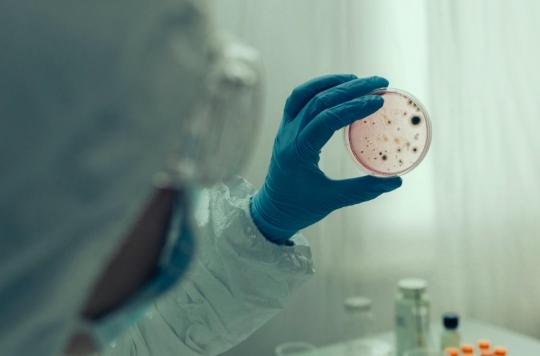
World premiere: youIn vivo studies carried out for the first time over 2 years on rats fed with a GMO and its associated herbicide, Roundup, the world’s best-selling herbicide, demonstrate its serious toxic effects.
A roundup tolerant GMO corn (NK603) was tested on rats for 2 years. This is the most detailed study ever carried out on rats fed for 2 years with a GMO corn which is tolerant to Roundup, that is to say capable of gorging on it without dying. The scientific journal ” Food and Chemical Toxicology ” has just published today the results of this study carried out by Prof. Gilles-Eric Séralini.
The published results highlight the importance of carrying out long-term tests before placing GMOs of this type on the market, whereas the current tests carried out by manufacturers only last 3 months …
Here is the interview we conducted for you with Dr Joel Spiroux, deputy director of the study carried out by the scientific team of Professor Seralini:
 Doctor Joël Spiroux, you have just published a scientific study with Professor Gilles-Eric Séralini which is alarming because it highlights the serious toxic effects of a GMO and its associated herbicide on health. It is a world first.
Doctor Joël Spiroux, you have just published a scientific study with Professor Gilles-Eric Séralini which is alarming because it highlights the serious toxic effects of a GMO and its associated herbicide on health. It is a world first.
I have the great pleasure of working for almost 15 years with my friend Gilles-Eric Séralini. I have a particular profile because I am a liberal doctor, and deputy director of the study we are talking about. This study is indeed a world first because no one in the world has carried out such a long and comprehensive study to test a GMO and its associated herbicide.
Can you explain to us in the preamble what a GMO is?
A GMO is a living organism (microorganism, plant, animal) having undergone an unnatural modification of its initial genetic characteristics, by addition, deletion or replacement of at least one gene. We therefore call GMO any organism harboring one or more genes from a species to which it does not belong. The “foreign genes” are then called transgenes, the GMO a transgenic organism. There are currently maize with up to 8 transgenes.
Why this study?
It seemed essential to us to test a food GMO tolerant to Roundup even though the manufacturers provide biological studies to obtain an agreement for the marketing of their products by the various governments. In fact, we consider that the studies provided by manufacturers are superficial and do not show signs of toxicity. For example the longest studies for a food GMO last only three months on rats and the formulated pesticides are not tested in the long term. In addition, it has been more than 10 years since in the laboratory of Gilles Eric Séralini, studies have been published highlighting the toxic effects “in vitro” of certain pesticides and in particular Roundup. I have even co-authored several publications highlighting signs of hepatic and renal toxicity in Monsanto studies, which were nevertheless accepted for marketing by regulatory agencies.
Where was it carried out and by whom?

It was carried out by the team of Prof. Gilles-Eric Séralini from the molecular biology laboratory of the University of Caen with the participation of a few external service providers and the support of CRIIGEN.
In which scientific journal was your study published?
Our study is published in one of the best international scientific journals of food toxicology and will be online from 19/09/12. His title:
”Long term toxicity of a Roundup herbicide and a Roundup-tolerant genetically modified maize”. Food and Chemical Toxicology, Séralini GE et al. 2012
What was his protocol?
This is the most detailed study ever carried out on rats fed for 2 years with GMO corn, NK603, which is tolerant to Roundup, that is to say capable of gorging itself without dying.
We took 10 groups of 10 male rats and 10 groups of 10 female rats. In males as in females we had 1 group of control rats, 3 groups of rats eating GMO alone at the dose of 11%, 22%, 33%, 3 groups of rats eating GMO at 11, 22, 33% sprayed during cultivation with Roundup, and 3 groups of rats eating non-GMO corn but drinking Roundup at three doses: that which can be found in tap water, that equivalent to Roundup residues tolerated in the diet and that corresponding to the dose likely to be absorbed by Roundup users.
In addition, throughout the 2 years, we carried out the most complete monitoring possible, weight, blood test and examinations of all organs at the end of the study. These tests therefore focused on the 200 rats observed for two years on more than one hundred parameters.
Why use rats?
These toxic products are not tested at the regulatory level on humans, but on rats. As a doctor, I prefer these products to be tested on rats rather than on the population as we are doing in so many countries around the world.
What are the differences with the regulatory studies required before marketing?
The primary difference is the duration. The regulatory studies only cover 3 months while our study covers 24 months. We assay more biological parameters and in particular hormonal parameters which are not assayed in regulatory studies. Yet it is well known that pesticides and in particular Roundup are endocrine disruptors !!!
What are the most significant results?
The first unexpected result is that the first rats died at 4 months, while the duration of regulatory studies is limited to 3 months!
Rats fed on GMOs, treated or not with Roundup die more quickly and in a more important way than the controls. Females mainly died from mammary tumors and pituitary abnormalities. Rats fed on GMOs, treated or not with Roundup had tumors more quickly and in a more important way than the controls. The majority of the males died of liver and kidney problems. Toxic metabolic effects are due to the GMO alone. Roundup has serious health effects at very low doses.
What societal benefits do you expect?
This study clearly shows that regulatory studies have large gaps that are too short, too superficial, incomplete and seemingly done so as not to highlight health effects. In addition, these studies are carried out and financed by the producers and the results interpreted by these same firms. This lack of independence is very damaging for the food security of the population. We can also accuse the laxity of the accreditation bodies.
We ask that the authorizations of these products be reviewed, that the 90-day tests be extended (2 years) for all GMOs, that the pesticides be tested for 2 years at low doses and in formulations and last point that the regulatory tests be public. , independent of companies, and subject to contradictory expertise.
You are both members of CRIIGEN; you are not unaware that some of your detractors consider you as “anti GMOs”, what do you have to answer me on this subject?
Many scientists belonging to CRIIGEN work in their laboratories on GMOs to better understand how genes work. As a doctor, I am very much in favor of the use of the transgenesis technique to obtain drugs such as the most emblematic of them: insulin. So you can see that at CRIIGEN we are not anti-GMOs, but we are against pesticide plants that are agricultural GMOs and which above all are poorly evaluated, as we have just shown.
What will be the follow-up to this study?
Before thinking about what to do next, I am convinced that our study will be the subject of numerous articles in the national press and among all the media. From now on, the results and the experience, its context and its social consequences are the subject of the book “Tous Cobayes! »By Gilles-Eric Séralini, published on 9/26 by Flammarion. A film is freely adapted from this work “Tous Cobayes? »By Jean-Paul Jaud; national cinema release on 9/26. A television documentary “GMOs, towards a global alert? »Was directed by François Le Bayon. The legal and societal impact is the subject of the book “The truth about GMOs is our business” by Corinne Lepage published by Charles Léopold Mayer editions.
Thereafter, from a scientific point of view we will have to continue to study all the results of this study and this will probably be the subject of 5 or 6 scientific publications.
Interview by Vianney Poissonnier















